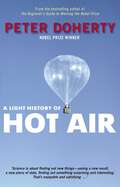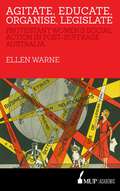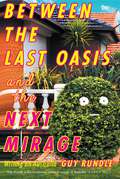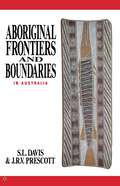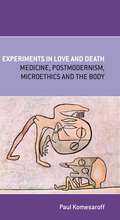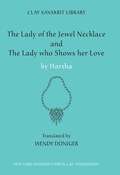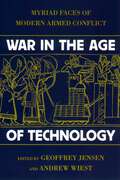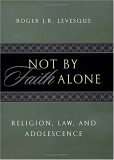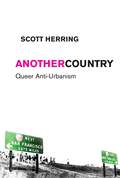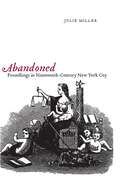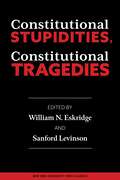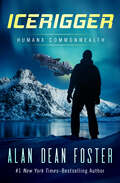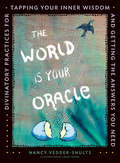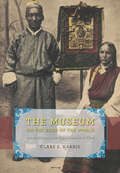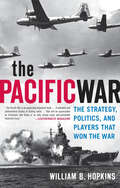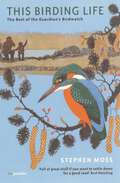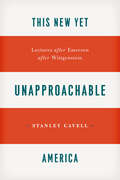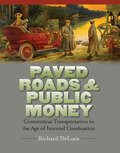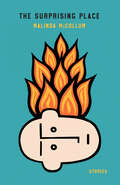- Table View
- List View
Light History of Hot Air
by Peter DohertyNobel Prize-winner Peter Doherty's enthusiasm and curiosity about the world around him informs this atmospheric collection of stories on illumination, hot air and burning in all their guises. Written with great style and richly intimate with personal anecdotes, A Light History of Hot Air is concerned with the world and the simple beauty of science. Doherty shines a unique, tangential light of insight that reveals his subjects in new and unexpected ways. A childhood in Queensland awakens a boy's-own-adventure enthusiasm for trains and ships; further learning leads to admiration for such engineering marvels as the humble refrigerator and the steady march of progress that has brought us from tallow candles to electric lights. Featuring cameos from Albert Einstein, Samuel Pepys, Charles Dickens and Thomas the Tank Engine, among others, A Light History of Hot Air is an unmissable treat.
Agitate, Educate, Organise, Legislate: Protestant Women's Social Action in Post-Suffrage Australia
by Ellen WarneAfter successfully agitating for the vote for women from the 1890s, Protestant women's organisations in Australia began to educate women at a grassroots level on effective ways of applying political pressure on a wide range of topics and social concerns. Positioning their organisations as non-party-political and separate from more overtly feminist groups, the Woman's Christian Temperance Union (WCTU); the Young Women's Christian Association (YWCA) and the Mothers' Union attracted women who were keen to work for change, and who were seeking to 'save' the individual as well as the greater society. These three organisations sought to agitate on a wide range of issues related to girls and women, connecting with public anxieties and highlighting particular vulnerabilities of girls and young women who lived alone in the city and had the potential to be exploited in the workforce. By the 1920s and 1930s these women's groups noted with concern the easier access to divorce and birth control in the Soviet Union and the growing influence of both Communism and 'Hitlerism' in galvanising young people. Agitate, Educate, Organise, Legislate explores the colourful debates and anxieties that were prevalent from the 1890s to the 1930s and the responses of the key women's organisations whose leadership and campaigns acknowledged that—outside of parliament and party politics—women's connection to political matters could be both innovative and socially influential.
Between the Last Oasis and the next Mirage: Writings on Australia
by Guy RundleFrom the coal blockade frontline of the Liverpool Plains to Hobart's Cat and Fiddle arcade, from being on the road with last chance Malcolm Turnbull to the fossil fuel fantasies of Adaniland in the north, Guy Rundle gives a first-hand history of Australia in the 2010's, after the brief and hopeful haha insurgency of the Rudd-Gillard-Rudd era and the descent of another decade of reaction. Through multiple elections, rubbing shoulders with the major players and upstart independents, Rundle describes a country changing and fracturing as the global wave of populism swept across conventional politics, and the culture wars solidified. He goes into battle, both against a corrupt, cynical and nihilistic right, and an increasingly elitist and fantastical progressivism. And he steps back into the past, looking at how we got to here, in memoirs and analyses of the shifting personal, cultural and political faultlines of the past half century. Between the Last Oasis and the Next Mirage is a raw, thoughtful, very funny and sometimes moving account of a nation dependent on the continuing good graces of history and the plain old dumb luck that is the land's curse.
Aboriginal Frontiers And Boundaries In Australia
by J. R. Prescott S. L. DavisBefore the coming of Europeans, Aboriginal communities lived within territories defined by complex ritual cycles of song, dance, symbol and ceremony. Knowledge of these boundaries and frontiers was in the keeping of senior custodians. In traditional communities, this continues to be the situation. Today, white Australians belatedly acknowledge Aboriginal land rights and the special significance of sacred sites. This makes an understanding of the boundaries vital to the achievement of basic land and sea rights for Aboriginal people. Unfortunately, over much of the continent, knowledge of boundaries has been lost or is in danger of being lost. In this work two political geographers explore the nature of Aboriginal boundaries and their contemporary implications. In four detailed case studies they challenge many of the assumptions which have underpinned the involvement of white advisers. The result is a timely study which raises important questions about an issue of national significance.
Experiments In Love and Death: Medicine, Postmodernism, Microethics and the Body
by Paul KomesaroffExperiments in Love and Death is about the depth and complexity of the ethical issues that arise in illness and medicine. In his concept of 'microethics' Paul Komesaroff provides an alternative to the abstract debates about principles and consequences that have long dominated ethical thought. He shows how ethical decisions are everywhere: in small decisions, in facial expressions, in almost inconspicuous acts of recognition and trust. Through powerful descriptions of case studies and clear and concise explanations of contemporary philosophical theory the book brings discussions about ethics in medicine back to where they belong; to the level of the everyday experience where people actually live, suffer and hope. A fresh and evocative look at the changing world of ethics as it applies to health and illness, this is an important book for all those touched by illness or suffering.
The Lady of the Jewel Necklace & The Lady who Shows her Love (Clay Sanskrit Library #17)
by HarshaKing Harsha, who reigned over the kingdom of Kanauj from 606 to 647 CE, composed two Sanskrit plays about the mythical figures of King Udayana, his queen, Vásava·datta, and two of his co-wives. The plays abound in mistaken identities, both political and erotic. The characters masquerade as one another and, occasionally, as themselves, and each play refers simultaneously to itself and to the other.Co-published by New York University Press and the JJC FoundationFor more on this title and other titles in the Clay Sanskrit series, please visit http://www.claysanskritlibrary.org
Unmanageable Care: An Ethnography of Health Care Privatization in Puerto Rico
by Jessica M. MulliganIn Unmanageable Care, anthropologist Jessica M. Mulligan goes to work at an HMO and records what it’s really like to manage care. Set at a health insurance company dubbed Acme, this book chronicles how the privatization of the health care system in Puerto Rico transformed the experience of accessing and providing care on the island. Through interviews and participant observation, the book explores the everyday contexts in which market reforms were enacted. It follows privatization into the compliance department of a managed care organization, through the visits of federal auditors to a health plan, and into the homes of health plan members who recount their experiences navigating the new managed care system.In the 1990s and early 2000s, policymakers in Puerto Rico sold off most of the island’s public health facilities and enrolled the poor, elderly and disabled into for-profit managed care plans. These reforms were supposed to promote efficiency, cost-effectiveness, and high quality care. Despite the optimistic promises of market-based reforms, the system became more expensive, not more efficient; patients rarely behaved as the expected health-maximizing information processing consumers; and care became more chaotic and difficult to access. Citizens continued to look to the state to provide health services for the poor, disabled, and elderly. This book argues that pro-market reforms failed to deliver on many of their promises. The health care system in Puerto Rico was dramatically transformed, just not according to plan.
War in the Age of Technology: Myriad Faces of Modern Armed Conflict
by Myriad Faces of Modern Armed ConflictTechnology of one kind or another has always been a central ingredient in war. The Spartan king Archidamus, for instance, reacted with alarm when first witnessing a weapon that could shoot darts through the air. And yet during the past two centuries technology has played an unprecedented role in military affairs and thinking, and in the overall conduct of war. In addition, the impact of new technology on warfare has brought major social and cultural changes. This volume explores the relationship between war, technology, and modern society over the course of the last several centuries. The two world wars, total conflicts in which industrial technology took a terrible human toll, brought great changes to the practice of organized violence among nations; even so many aspect of military life and values remained largely unaffected. In the latter half of the twentieth century, technology in the form of nuclear deterrence appears to have prevented the global conflagration of world war while complicating and fueling ferocious regional contests. A stimulating fusion of military and social history, extending back to the eighteenth century, and with contributions from such leading historians as Brian Bond, Paddy Griffith, and Neil McMillen, War in the Age of Technology will interest lay readers and specialists alike.
Not by Faith Alone: Religion, Law, and Adolescence
by Roger J.R. LevesqueTeens are often seen as challenging social mores. They are frequently perceived to engage in activities considered by adults to be immoral, including sexual behavior, delinquent activities, and low-level forms of violence. Yet the vast majority report surprisingly high levels of religiosity. Ninety-five percent of American teens aged 13-17 believe in God or a universal spirit, and 76% believe that God observes their actions and rewards or punishes them. Nearly half engage in religious practices, such as praying alone or attending church or synagogue services. Adolescents' religious beliefs are clearly important to them. Yet, the law does not know how to approach adolescents' religious rights and needs. In Not by Faith Alone, Roger J. R. Levesque argues that teens' search for meaning does not always serve adolescents or society well. Religious doctrines and institutions are not all "good," with violence linked to religious beliefs, for example—particularly racial/ethnic and sexual orientation harassment—becoming an increasing concern. Not by Faith Alone is the first attempt to integrate research on the place of religion in adolescent development and to discuss the relevance of that research for policies and laws which regulate religion in their lives. Levesque asks how religion, broadly defined, influences the development of teens' inner moral compasses, and how we can ensure that religion and the apparent need for "religious" activity lead to positive outcomes for individual adolescents and for society.
Another Country: Queer Anti-Urbanism (Sexual Cultures #21)
by Scott HerringThe metropolis has been the near exclusive focus of queer scholars and queer cultures in America. Asking us to look beyond the cities on the coasts, Scott Herring draws a new map, tracking how rural queers have responded to this myopic mindset. Interweaving a wide range of disciplines—art, media, literature, performance, and fashion studies—he develops an extended critique of how metronormativity saturates LGBTQ politics, artwork, and criticism. To counter this ideal, he offers a vibrant theory of queer anti-urbanism that refuses to dismiss the rural as a cultural backwater.Impassioned and provocative, Another Country expands the possibilities of queer studies beyond its city limits. Herring leads his readers from faeries in the rural Midwest to photographs of white supremacists in the deep South, from Roland Barthes’s obsession with Parisian fashion to a graphic memoir by Alison Bechdel set in the Appalachian Mountains, and from cubist paintings in Lancaster County to lesbian separatist communes on the northern California coast. The result is an entirely original account of how queer studies can—and should—get to another country.
Automats, Taxi Dances, and Vaudeville: Excavating Manhattan’s Lost Places of Leisure
by David FreelandWinner of the Publication Award for Popular Culture and Entertainment for 2009 from the Metropolitan Chapter of the Victorian Society in AmericaNamed to Pop Matters list of the Best Books of 2009 (Non-fiction)From the lights that never go out on Broadway to its 24-hour subway system, New York City isn't called "the city that never sleeps" for nothing. Both native New Yorkers and tourists have played hard in Gotham for centuries, lindy hopping in 1930s Harlem, voguing in 1980s Chelsea, and refueling at all-night diners and bars. The slim island at the mouth of the Hudson River is packed with places of leisure and entertainment, but Manhattan's infamously fast pace of change means that many of these beautifully constructed and incredibly ornate buildings have disappeared, and with them a rich and ribald history.Yet with David Freeland as a guide, it's possible to uncover skeletons of New York's lost monuments to its nightlife. With a keen eye for architectural detail, Freeland opens doors, climbs onto rooftops, and gazes down alleyways to reveal several of the remaining hidden gems of Manhattan's nineteenth- and twentieth-century entertainment industry. From the Atlantic Garden German beer hall in present-day Chinatown to the city's first motion picture studio—Union Square's American Mutoscope and Biograph Company—to the Lincoln Theater in Harlem, Freeland situates each building within its historical and social context, bringing to life an old New York that took its diversions seriously. Freeland reminds us that the buildings that serve as architectural guideposts to yesteryear's recreations cannot be re-created—once destroyed they are gone forever. With condominiums and big box stores spreading over city blocks like wildfires, more and more of the Big Apple's legendary houses of mirth are being lost. By excavating the city's cultural history, this delightful book unearths some of the many mysteries that lurk around the corner and lets readers see the city in a whole new light.
Abandoned: Foundlings in Nineteenth-Century New York City
by Julie MillerTwo interesting items: The author's article in New York ArchivesA letter regarding foundlings in The Riverdale PressIn the nineteenth century, foundlings—children abandoned by their desperately poor, typically unmarried mothers, usually shortly after birth—were commonplace in European society. There were asylums in every major city to house abandoned babies, and writers made them the heroes of their fiction, most notably Charles Dickens's Oliver Twist. In American cities before the Civil War the situation was different, with foundlings relegated to the poorhouse instead of institutions designed specifically for their care. By the eve of the Civil War, New York City in particular had an epidemic of foundlings on its hands due to the rapid and often interlinked phenomena of urban development, population growth, immigration, and mass poverty. Only then did the city's leaders begin to worry about the welfare and future of its abandoned children.In Abandoned, Julie Miller offers a fascinating, frustrating, and often heartbreaking history of a once devastating, now forgotten social problem that wracked America's biggest metropolis, New York City. Filled with anecdotes and personal stories, Miller traces the shift in attitudes toward foundlings from ignorance, apathy, and sometimes pity for the children and their mothers to that of recognition of the problem as a sign of urban moral decline and in need of systematic intervention. Assistance came from public officials and religious reformers who constructed four institutions: the Nursery and Child's Hospital's foundling asylum, the New York Infant Asylum, the New York Foundling Asylum, and the public Infant Hospital, located on Randall's Island in the East River.Ultimately, the foundling asylums were unable to significantly improve children’s lives, and by the early twentieth century, three out of the four foundling asylums had closed, as adoption took the place of abandonment and foster care took the place of institutions. Today the word foundling has been largely forgotten. Fortunately, Abandoned rescues its history from obscurity.
Constitutional Stupidities, Constitutional Tragedies
by Sanford Levinson William N. Eskridge JR.The Constitution is the cornerstone of American government, hailed as one of the greatest contributions of the Western Enlightenment. While many seem content simply to celebrate it, those most familiar with the document invariably find it wanting in at least some aspects. This unique volume brings together many of the country's most esteemed constitutional commentators and invites them to answer two questions: First, what is the stupidest provision of the Constitution? "Stupid" need not mean evil. Thus, a second, related question is whether the scholar-interpreter would be forced to reach truly evil results even if applying his or her own favored theory of constitutional interpretation. The contributors include Lawrence Alexander, Akhil Reed Amar, Jack Balkin, Philip Bobbitt, Gerard Bradley, Rebecca Brown, Steven Calabresi, Lief Carter, Christopher Eisgruber, Lawrence Sager, Marie Failinger, Daniel Farber, James Fleming, Mark Graber, Stephen Griffin, Gary Jacobsohn, Randall Kennedy, Lewis LaRue, Theodore Lowi, Earl Maltz, Michael McConnell, Matthew Michael, Robert Nagel, Daniel Ortiz, Pamela Karlen, Michael Paulsen, Robert Post, Lucas Powe, Dorothy Roberts, Jeffrey Rosen, Frederick Schauer, Michael Seidman, Suzanna Sherry, David Strauss, Laurence Tribe, Mark Tushnet, and John Yoo.
Icerigger: Icerigger, Mission To Moulokin, And The Deluge Drivers (Humanx Commonwealth)
by Alan Dean FosterA band of humans struggle to survive when they crash-land on an icy planet, in this science fiction adventure by the #1 New York Times bestseller. A sophisticated interstellar traveler, Ethan Frome Fortune is a businessman on board the interstellar transport ship Antares. He isn&’t one for heroism or adventure. That would be his fellow passenger (and giant of a man), Skua September. Regardless, both soon get a chance to test their mettle . . . Tran-ky-ky is an icy, desolate planet sharply carved by hurricane-force winds. It&’s a terrible place for an emergency landing, but a botched kidnapping on the Antares sends Ethan, Skua, and some of their fellow travelers hurtling toward the stormy planet. Now, surrounded by hungry killer plants and cat-like natives, this ragged bunch of castaways led by Ethan must keep their wits about them if they ever hope to escape . . .
The World Is Your Oracle: Divinatory Practices for Tapping Your Inner Wisdom and Getting the Answers You Need
by Nancy Vedder-ShultsA global guide to divination that explores ancient and modern tools appropriate for a variety of intuitive styles.The World Is Your Oracle is an invitation to discover ancient and contemporary divination, enabling you to craft your own questions, delve into your inner wisdom, and find the answers you have been searching for. This innovative divination book presents multicultural techniques from around the world—both ancient and contemporary—designed for each person’s unique situation, desire, or intuitive style.Nancy Vedder-Shults, PhD, presents you with all the information you will need to select the most effective technique for you based on what appeals to you, whether it be kinesthetic, auditory or visual. Or you can simply work your way through all the practices for fun and self-awareness.
The Museum on the Roof of the World: Art, Politics, and the Representation of Tibet (Buddhism And Modernity Ser.)
by Clare E. HarrisFor millions of people around the world, Tibet is a domain of undisturbed tradition, the Dalai Lama a spiritual guide. By contrast, the Tibet Museum opened in Lhasa by the Chinese in 1999 was designed to reclassify Tibetan objects as cultural relics and the Dalai Lama as obsolete. Suggesting that both these views are suspect, Clare E. Harris argues in The Museum on the Roof of the World that for the past one hundred and fifty years, British and Chinese collectors and curators have tried to convert Tibet itself into a museum, an image some Tibetans have begun to contest. This book is a powerful account of the museums created by, for, or on behalf of Tibetans and the nationalist agendas that have played out in them. Harris begins with the British public’s first encounter with Tibetan culture in 1854. She then examines the role of imperial collectors and photographers in representations of the region and visits competing museums of Tibet in India and Lhasa. Drawing on fieldwork in Tibetan communities, she also documents the activities of contemporary Tibetan artists as they try to displace the utopian visions of their country prevalent in the West, as well as the negative assessments of their heritage common in China. Illustrated with many previously unpublished images, this book addresses the pressing question of who has the right to represent Tibet in museums and beyond.
Lost Wonderland: The Brief and Brilliant Life of Boston's Million Dollar Amusement Park
by Stephen R. WilkIf you take Boston's Blue Line to its northern end, you'll reach the Wonderland stop. Few realize that a twenty-three-acre amusement park once sat nearby—the largest in New England, and grander than any of the Coney Island parks that inspired it. Opened in Revere on Memorial Day in 1906 to great fanfare, Wonderland offered hundreds of thousands of visitors recreation by the sea, just a short distance from downtown Boston. The story of the park's creation and wild, but brief, success is full of larger-than-life characters who hoped to thrill attendees and rake in profits. Stephen R. Wilk describes the planning and history of the park, which featured early roller coasters, a scenic railway, a central lagoon in which a Shoot-the-Chutes boat plunged, an aerial swing, a funhouse, and more. Performances ran throughout the day, including a daring Fires and Flames show; a Wild West show; a children's theater; and numerous circus acts. While nothing remains of what was once called "Boston's Regal Home of Pleasure" and the park would close in 1910, this book resurrects Wonderland by transporting readers through its magical gates.
The Pacific War: The Strategy, Politics, and Players That Won the War
by William B. HopkinsThis “important comprehensive study” of WWII in the Pacific examines the high-level decision-making and strategy that led to victory (Roanoke Times).Once the stories have been told of battles won and lost, most of what happens in a war remains a mystery. So it has been with accounts of World War II in the Pacific, a complex conflict whose nature is often obscured by simple chronological narratives. In The Pacific War, William B. Hopkins, a Marine Corps veteran of the Pacific war and respected military history author, opens the story of the Pacific campaign to a broader and deeper view.Hopkins investigates the strategies, politics, and personalities that shaped the fighting. His regional approach to this complex war conducted on land, sea, and air offers an insightful perspective on how this multifaceted conflict unfolded. As expansive as the immense reaches of the Pacific, and as focused as the most intensive pinpoint attack on a strategic island, Hopkins’ account offers a fresh way of understanding the hows—and more significantly, the whys—of the Pacific War.
To Be a U.S. Secret Service Agent
by Henry M. HoldenA look inside the renowned law enforcement agency—its history, its recruiting and training process, and tips for those seeking a Secret Service career.The Secret Service was established after the Civil War by the Treasury Department, originally to protect American currency against counterfeiters. It was only after the assassination of President William McKinley in 1901 that Congress directed the Secret Service to protect the President of the United States. Today, protection remains the primary mission of the United States Secret Service.It takes a special type of individual to be a U.S. Secret Service agent, one willing to “take a bullet” to preserve the ideals on which the United States was founded. To Be a U.S. Secret Service Agent lifts the curtain for a look inside this law enforcement agency, including the highly selective recruiting, the intense training, and the specialized weapons and equipment used to protect current and past presidents, vice presidents, their families, and visiting heads of state.Includes photos
This Birding Life: The Best of the Guardian's Birdwatch
by Stephen MossThis collection of essays “gives bird enthusiasts the next best thing to birdwatching, an eloquent and insightful consideration of birds and birding” (Publishers Weekly).Stephen Moss’s collection of Guardian “Birdwatch” columns forms a fascinating picture of one man’s birding life: from early coot-watching as a young boy, through teenage cycle trips to Dungeness, to adult travels around the world as a TV producer working everywhere from the Gambia to Antarctica.Drawing on nearly twenty years of columns for the Guardian, Stephen covers local, national and foreign birding encounters. From the (varying) excitement and peace of his chosen pursuit, to the growing uncertainties posed by climate change, the author brings an enthusiasm and sincerity to the subject that will energise even the most fair-weather of birdwatchers.
This New Yet Unapproachable America: Lectures after Emerson after Wittgenstein (Frederick Ives Carpenter Lectures; Ser.)
by Stanley CavellStanley Cavell is a titan of the academic world; his work in aesthetics and philosophy has shaped both fields in the United States over the past forty years. In this brief yet enlightening collection of lectures, Cavell investigates the work of two of his most tried-and-true subjects: Emerson and Wittgenstein. Beginning with an introductory essay that places his own work in a philosophical and historical context, Cavell guides his reader through his thought process when composing and editing his lectures while making larger claims about the influence of institutions on philosophers, and the idea of progress within the discipline of philosophy. In “Declining Decline,” Cavell explains how language modifies human existence, looking specifically at the culture of Wittgenstein’s writings. He draws on Emerson, Thoreau, and many others to make his case that Wittgenstein can indeed be viewed as a “philosopher of culture.” In his final lecture, “Finding as Founding,” Cavell writes in response to Emerson’s “Experience,” and explores the tension between the philosopher and language—that he or she must embrace language as his or her “form of life,” while at the same time surpassing its restrictions. He compares finding new ideas to discovering a previously unknown land in an essay that unabashedly celebrates the power and joy of philosophical thought.
Paved Roads & Public Money: Connecticut Transportation in the Age of Internal Combustion (The Driftless Connecticut Series & Garnet Books)
by Richard DeLucaPaved Roads & Public Money describes the evolution of transportation systems in modern Connecticut. It is the second book in a two-volume study that begins with the bicycle craze of the 1880s, and ends with the efforts of the Malloy and Lamont administrations to revitalize Connecticut transportation in the twenty-first century. The story includes aviation, highways, bridges, ferries, steamboats, canals, railroads, electric trolleys, and water ports in Connecticut and along the multi-state travel corridor from New York to Boston. Drawing on a wide array of primary material, Richard DeLuca examines how land, law, and technology have shaped the state and its transportation systems, giving special attention to the state's two largest transportation monopolies: the New Haven Railroad and the Connecticut Department of Transportation. The book focuses on key events in the development of transportation and legislation. It is arranged chronologically, and by highlighting themes from each period shows the implications of the state's transportation history on current debates about infrastructure and funding. It features 50 illustrations and three appendices: population by geomorphic region, a list of controlled access highways, and a list of notable highway bridges.
The Surprising Place: Stories (Juniper Prize for Fiction)
by Malinda McCollumA synchronized swimming coach pops pills during practice, a bagpiper cold-cocks a hawk, and an orphan puts her fist through a window, discovering in the engine noise of a jet passing overhead, the perfect witness to her inner pain. In this debut collection from prizewinning short story writer Malinda McCollum, people adrift in the American Midwest struggle to find their way in the world, with few signposts for guidance. Set largely in Des Moines, Iowa, over the expanse of several decades, these twelve stories explore the surprising places where our outsized longings may lead us. In prose as lean and unflinching as an Iowa winter, these stories offer confrontation and consolation in equal measure.
Ransomware: Defending Against Digital Extortion
by Allan Liska Timothy GalloThe biggest online threat to businesses and consumers today is ransomware, a category of malware that can encrypt your computer files until you pay a ransom to unlock them. With this practical book, you’ll learn how easily ransomware infects your system and what steps you can take to stop the attack before it sets foot in the network.Security experts Allan Liska and Timothy Gallo explain how the success of these attacks has spawned not only several variants of ransomware, but also a litany of ever-changing ways they’re delivered to targets. You’ll learn pragmatic methods for responding quickly to a ransomware attack, as well as how to protect yourself from becoming infected in the first place.Learn how ransomware enters your system and encrypts your filesUnderstand why ransomware use has grown, especially in recent yearsExamine the organizations behind ransomware and the victims they targetLearn how wannabe hackers use Ransomware as a Service (RaaS) to launch campaignsUnderstand how ransom is paid—and the pros and cons of payingUse methods to protect your organization’s workstations and servers
Essential Silverlight 2 Up-to-Date
by Christian WenzDesign rich Internet applications (RIAs) for the Web using Silverlight 2, Microsoft's hot runtime application. Available only as an ebook, this concise, easy-to-understand introduction provides complete step-by-step instructions for using everything Silverlight 2 has to offer, including tools for animation, vector graphics, video playback, .NET support for web services and networking, as well as LINQ, Microsoft's native data querying tool. Essential Silverlight 2 helps you take advantage of Microsoft's cross-browser plug-in with:Clever ways to create interactive UIs that are more robust and easier to debug and test than what you can achieve on other platformsScores of tested JavaScript and C# code examples that you can reuse in your own applicationsExpert guidance from an author who understands RIA technologies, including ASP.NET, Flash, PHP, and JavaScriptReady to deliver a more complete Web experience? Essential Silverlight 2 offers a world of possibilities.
